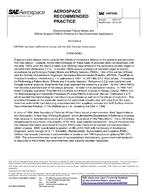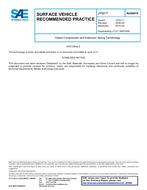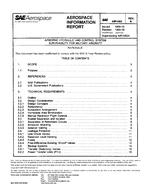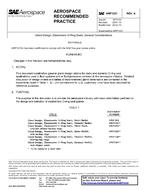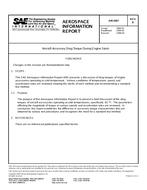Provide PDF Format
SAE ARP5580
- Recommended Failure Modes and Effects Analysis (FMEA) Practices for Non-Automobile Applications
- standard by SAE International, 05/01/2012
- Publisher: SAE
$37.00$74.00
Recommended Failure Modes and Effects Analysis (FMEA) Practices for Non-Automobile Applications describes the basic procedures for performing a Failure Modes and Effects Analysis (FMEA). It encompasses functional, interface, and detailed FMEA, as well as certain pre-analysis activities (FMEA planning and functional requirements analysis), post-analysis activities (failure latency analysis, FMEA verification, and documentation), and applications to hardware, software, and process design. It is intended for use by organizations whose product development processes use FMEA as a tool for assessing the safety and reliability of system elements, or as part of their product improvement processes. A separate, Surface Vehicle Recommended Practice, J1739, is intended for use in automobile applications.Purpose: In developing this procedure the subcommittee has endeavored to develop a procedure that reflects the best current commercial practices. This procedure was developed in recognition of today's intense and competitive market demands for high reliability, affordability, and speed to market. The subcommittee had several objectives in defining the FMEA process: 1. Define a basic methodology to include functional, interface, and detailed FMEA. This will facilitate performing the analysis throughout the design process, from early in the conceptual stage to implementation and production. 2. Extend the methodology to include both product and process FMEAs. The methodology can be applied to the many technologies (e.g., mechanical, electrical, software, etc.) used in the development of a product. This helps to facilitate communications between all the parties involved in the development of a system and is useful in a concurrent engineering environment. 1. Provide simple techniques for ranking failure modes for corrective actions and for identifying fault equivalencies. 2. Define the types of information needed for the FMEA in electronic databases, thus facilitating semi-automation of the analysis. 3. Provide procedures for managing the FMEA and for getting the most benefit from the analysis.
Related Products
SAE J1121_201608
Helical Compression and Extension Spring Terminology (Stabilized: Aug 2016)..
$37.00 $74.00
SAE AIR 1083B
Airborne Hydraulic and Control System Survivability For Military Aircraft ( Reaffirmed: Jun 2007 )..
$37.00 $74.00

